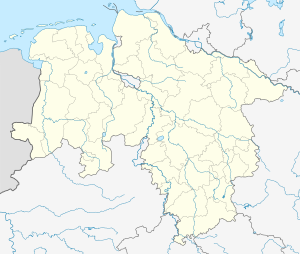Eggebunnel
| Eggebunnel | ||
|---|---|---|
|
South portal of the tunnel with a road bridge in front
|
||
| traffic connection | SFS Hannover – Würzburg | |
| length | 332 m | |
| Number of tubes | 1 | |
| Largest coverage | 28 m | |
| construction | ||
| Client | German Federal Railroad | |
| completion | July 1986 | |
| business | ||
| operator | DB network | |
| release | 1991 | |
| location | ||
|
|
||
| Coordinates | ||
| North portal | 52 ° 4 ′ 27 " N , 9 ° 53 ′ 57" E | |
| South portal | 52 ° 4 ′ 19 ″ N , 9 ° 54 ′ 6 ″ E | |
The Eggebergtunnel is a 332 meter long railway tunnel on the high-speed line from Hanover to Würzburg ( route kilometers 36.8 to 37.1).
course

The route runs straight in the tunnel. The gradient slopes down towards the south portal and reaches a gradient of 12.493 per mille in this area. Half of the tube lies in the lower and half in the upper shell limestone . The maximum cover is 28 meters.
The north portal is preceded by an approximately 110 m long pre-cut. There is also a cut to the south of the tunnel. After crossing the state road 485, two forest roads and the Salterbeek on a six-span bridge, the southern foreland of the Hildesheim forest joins. To the north, after a short dam, the Eichenberg tunnel follows .
history
planning
The current route between Hanover and Kassel was decided in 1976 (so-called variant III ). In 1976 and 1977, a variant IV was discussed at times after geologists questioned the feasibility of variant III in the Hildesheim forest. At Sarstedt, this variant IV would have swiveled off the current route in a westerly direction and would have circumnavigated the Hildesheim forest parallel to the current route in an approximately four kilometer long tunnel between Nordstemmen in the north and Eddinghausen in the south, in order to then approach the realized route and this north from Sibbesse to reach. After exploratory drilling in 1976 and 1977 confirmed the feasibility of variant III, this variant was introduced into spatial planning by the Federal Railroad in 1977.
In the planning phase, the tunnel was in section 1 in the 133 km long northern section of the new line. This part ends south of the tunnel at km 39.650. In the planning approval procedure, the tube was part of section 1.5.
In mid-1982 the planned length was 323 m, at the end of 1982 it was 332 m.
construction
The eruption rose from south to north and was completed in July 1985. The shell was completed in July 1986. The excavated material was partly used as dam construction material and partly taken to a landfill on the side. The inner shell is 35 centimeters thick along its entire length. The construction cost for the structure, including the neighboring Eichenberg tunnel, was 45 million DM.
Web links
- Photos of the tunnel portals and the surrounding area on eisenbahn-tunnelportale.de
Individual evidence
- ↑ a b c d Deutsche Bundesbahn, Federal Railway Directorate Hanover, project group Hanover – Würzburg North of the railway construction center: Tunnel construction in the northern section of the new Hanover – Würzburg line , brochure (22 pages), status: January 1987, p. 9
- ↑ a b c d DB project group Hanover-Würzburg (North) (Ed.): New Hanover – Würzburg line: Sibbesse municipality. , Brochure (18 pages, folded) as of August 1, 1982.
- ↑ Helmut Weber, Walter Engels, Helmut Maak: The new Hanover – Würzburg line . In: Railway technical review . 28, No. 10, 1979, pp. 725-734.
- ^ DB project group Hanover-Würzburg (North) (Ed.): Hildesheimer Wald , brochure (16 pages, folded) as of March 1, 1984.
- ^ DB project group Hanover-Würzburg (North) (ed.): New line Hanover-Würzburg: Sorsum, Klein Escherde, Groß Escherde . Leporello (14 pages) as of December 1, 1982.

